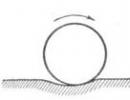The concept of a point function has a geometric meaning. Definition of derivative, its geometric meaning. Geometric and physical meaning of derivative
Subject. Derivative. Geometric and mechanical meaning of derivative
If this limit exists, then the function is said to be differentiable at a point. The derivative of a function is denoted by (formula 2).

- Geometric meaning of derivative. Let's look at the graph of the function. From Fig. 1 it is clear that for any two points A and B of the graph of the function, formula 3 can be written). It contains the angle of inclination of the secant AB.
Thus, the difference ratio is equal to the slope of the secant. If you fix point A and move point B towards it, then it decreases without limit and approaches 0, and the secant AB approaches the tangent AC. Therefore, the limit of the difference ratio is equal to the slope of the tangent at point A. This leads to the conclusion.
The derivative of a function at a point is the slope of the tangent to the graph of this function at that point. This is the geometric meaning of the derivative.
- Tangent equation . Let us derive the equation of the tangent to the graph of the function at a point. In the general case, the equation of a straight line with an angular coefficient has the form: . To find b, we take advantage of the fact that the tangent passes through point A: . This implies: . Substituting this expression instead of b, we obtain the tangent equation (formula 4).

Mathematical problems find their application in many sciences. These include not only physics, chemistry, technology and economics, but also medicine, ecology and other disciplines. One important concept to master in order to find solutions to important dilemmas is the derivative of a function. Its physical meaning is not at all as difficult to explain as it might seem to those uninitiated into the essence of the issue. It is enough just to find suitable examples of this in real life and ordinary everyday situations. In fact, any motorist copes with a similar task every day when he looks at the speedometer, determining the speed of his car at a specific instant of fixed time. After all, it is precisely this parameter that contains the essence of the physical meaning of the derivative.
How to find speed
Any fifth grader can easily determine the speed of a person on the road, knowing the distance traveled and travel time. To do this, divide the first of the given values by the second. But not every young mathematician knows that they are currently finding the ratio of increments of a function and an argument. Indeed, if you imagine the movement in the form of a graph, plotting the path along the ordinate axis and time along the abscissa, it will be exactly like this.
However, the speed of a pedestrian or any other object, which we determine over a large section of the path, considering the movement to be uniform, may well change. There are many forms of motion known in physics. It can occur not only with constant acceleration, but also slow down and increase in an arbitrary manner. It should be noted that in this case the line describing the movement will no longer be a straight line. Graphically, it can take on the most complex configurations. But for any of the points on the graph, we can always draw a tangent, represented by a linear function.
To clarify the parameter of change in displacement depending on time, it is necessary to shorten the measured segments. When they become infinitesimal, the calculated speed will be instantaneous. This experience helps us define a derivative. Its physical meaning also logically follows from such reasoning.

From a geometry point of view
It is known that the greater the speed of the body, the steeper the graph of the dependence of displacement on time, and therefore the angle of inclination of the tangent to the graph at a certain point. An indicator of such changes can be the tangent of the angle between the abscissa axis and the tangent line. It is precisely this that determines the value of the derivative and is calculated by the ratio of the lengths of the opposite to the adjacent leg in a right triangle formed by a perpendicular dropped from a certain point onto the abscissa axis.
This is the geometric meaning of the first derivative. The physical one is revealed in the fact that the value of the opposite side in our case represents the distance traveled, and the adjacent side represents time. In this case, their ratio is speed. And again we come to the conclusion that the instantaneous speed, determined when both intervals tend to infinitesimal, is the essence, indicating its physical meaning. The second derivative in this example will be the acceleration of the body, which in turn demonstrates the degree of change in speed.

Examples of finding derivatives in physics
The derivative is an indicator of the rate of change of any function, even when we are not talking about movement in the literal sense of the word. To clearly demonstrate this, we will give several specific examples. Suppose the current strength, depending on time, changes according to the following law: I= 0.4t 2 . It is required to find the value of the speed at which this parameter changes at the end of the 8th second of the process. Note that the desired value itself, as can be judged from the equation, is constantly increasing.
To solve, it is necessary to find the first derivative, the physical meaning of which was discussed earlier. Here dI/ dt = 0,8 t. Next we will find it at t=8 , we find that the rate at which the current changes occurs is equal to 6,4 A/ c. Here it is considered that the current strength is measured in amperes, and time, accordingly, in seconds.
Everything is changeable
The visible surrounding world, consisting of matter, is constantly undergoing changes, being in the movement of various processes occurring in it. A variety of parameters can be used to describe them. If they are united by a dependence, then they are written mathematically in the form of a function that clearly shows their changes. And where there is movement (in whatever form it may be expressed), there also exists a derivative, the physical meaning of which we are considering at the present moment.

The following example is about this. Let's say body temperature changes according to the law T=0,2 t 2 . You should find the rate of its heating at the end of the 10th second. The problem is solved in a manner similar to that described in the previous case. That is, we find the derivative and substitute the value for t= 10 , we get T= 0,4 t= 4. This means that the final answer is 4 degrees per second, that is, the heating process and temperature change, measured in degrees, occurs at exactly this speed.
Solving practical problems
Of course, in real life everything can be much more complicated than in theoretical problems. In practice, the value of quantities is usually determined during an experiment. In this case, instruments are used that give readings during measurements with a certain error. Therefore, when calculating, you have to deal with approximate values of the parameters and resort to rounding of inconvenient numbers, as well as other simplifications. Having taken this into account, let us again proceed to problems on the physical meaning of the derivative, taking into account that they are only a kind of mathematical model of the most complex processes occurring in nature.
Eruption
Let's imagine that a volcano is erupting. How dangerous can he be? To clarify this issue, many factors need to be considered. We will try to take one of them into account.

From the mouth of the “fire monster” stones are thrown vertically upward, having an initial speed from the moment they come out. It is necessary to calculate what maximum height they can reach.
To find the desired value, we will draw up an equation for the dependence of height H, measured in meters, on other values. These include initial speed and time. We consider the acceleration value to be known and approximately equal to 10 m/s 2 .

Partial derivative
Let us now consider the physical meaning of the derivative of a function from a slightly different angle, because the equation itself may contain not one, but several variables. For example, in the previous problem, the dependence of the height of the rise of stones thrown out of a volcano’s mouth was determined not only by a change in time characteristics, but also by the value of the initial speed. The latter was considered a constant, fixed value. But in other problems with completely different conditions, everything could be different. If there are several quantities on which a complex function depends, calculations are made according to the formulas below.

The physical meaning of the frequent derivative should be determined as in the usual case. This is the rate of change of a function at a certain point as the parameter of the variable increases. It is calculated in such a way that all other components are taken as constants, only one is considered as a variable. Then everything happens according to the usual rules.
Understanding the physical meaning of the derivative, it is not difficult to give examples of solving intricate and complex problems, the answer to which can be found with such knowledge. If we have a function that describes fuel consumption depending on the speed of the car, we can calculate at what parameters of the latter the gasoline consumption will be the least.
In medicine, it is possible to predict how the human body will react to a medicine prescribed by a doctor. Taking the drug affects a variety of physiological indicators. These include changes in blood pressure, heart rate, body temperature and more. They all depend on the dose of the drug taken. These calculations help to predict the course of treatment, both in favorable manifestations and in undesirable events that can fatally affect changes in the patient’s body.

Undoubtedly, it is important to understand the physical meaning of the derivative in technical matters, in particular in electrical engineering, electronics, design and construction.
Braking distances
Let's consider the next problem. Moving at a constant speed, the car, approaching the bridge, was forced to brake 10 seconds before the entrance, as the driver noticed a road sign prohibiting movement at a speed of more than 36 km/h. Did the driver break the rules if his braking distance can be described by the formula S = 26t - t 2?
Having calculated the first derivative, we find a formula for speed, we get v = 28 - 2t. Next, we substitute the value t=10 into the indicated expression.
Since this value was expressed in seconds, the speed turns out to be 8 m/s, which means 28.8 km/h. This makes it possible to understand that the driver started to brake on time and did not violate the traffic rules, and therefore the speed limit indicated on the sign.
This proves the importance of the physical meaning of the derivative. An example of solving this problem demonstrates the breadth of use of this concept in various areas of life. Including in everyday situations.

Derivative in economics
Until the 19th century, economists mainly operated with averages, be it labor productivity or the price of manufactured products. But at some point, limit values became more necessary to make effective forecasts in this area. These may include marginal utility, income or costs. Understanding this gave impetus to the creation of a completely new tool in economic research, which has existed and developed for more than a hundred years.
To draw up such calculations, where such concepts as minimum and maximum dominate, it is simply necessary to understand the geometric and physical meaning of the derivative. Among the creators of the theoretical basis of these disciplines one can name such prominent English and Austrian economists as W. S. Jevons, K. Menger and others. Of course, it is not always convenient to use limit values in economic calculations. And, for example, quarterly reports do not necessarily fit into the existing scheme, but still the application of such a theory in many cases is useful and effective.
Lecture: The concept of the derivative of a function, the geometric meaning of the derivative
The concept of a derivative function
Let us consider some function f(x), which will be continuous over the entire interval of consideration. On the interval under consideration, we select the point x 0, as well as the value of the function at this point.

So, let's look at the graph on which we mark our point x 0, as well as the point (x 0 + ∆x). Recall that ∆х is the distance (difference) between two selected points.
It is also worth understanding that each x corresponds to its own value of the function y.
The difference between the values of the function at the point x 0 and (x 0 + ∆x) is called the increment of this function: ∆у = f(x 0 + ∆x) - f(x 0).
Let's pay attention to the additional information that is available on the graph - this is the secant, which is called KL, as well as the triangle that it forms with intervals KN and LN.
The angle at which the secant is located is called its angle of inclination and is denoted α. It can be easily determined that the degree measure of the angle LKN is also equal to α.
Now let's remember the relationships in a right triangle tgα = LN / KN = ∆у / ∆х.
That is, the tangent of the secant angle is equal to the ratio of the increment of the function to the increment of the argument.
At one time, the derivative is the limit of the ratio of the increment of a function to the increment of the argument on infinitesimal intervals.

The derivative determines the rate at which a function changes over a certain area.
Geometric meaning of derivative
If you find the derivative of any function at a certain point, you can determine the angle at which the tangent to the graph in a given current will be located, relative to the OX axis. Pay attention to the graph - the tangential slope angle is denoted by the letter φ and is determined by the coefficient k in the equation of the straight line: y = kx + b.
That is, we can conclude that the geometric meaning of the derivative is the tangent of the tangent angle at some point of the function.
Let's consider an arbitrary straight line passing through a point on the graph of a function - point A(x 0, f (x 0)) and intersecting the graph at some point B(x; f(x )). Such a line (AB) is called a secant. From ∆ABC: AC = ∆ x ; ВС =∆у; tgβ =∆ y /∆ x .
Since AC || Ox, then Ð ALO = Ð BAC = β (as corresponding when parallel). ButÐ ALO is the angle of inclination of the secant AB to the positive direction of the Ox axis. Means, tgβ = k - angular coefficient of straight line AB.
Now we will reduce ∆x, i.e. ∆х→ 0. In this case, point B will approach point A according to the graph, and secant AB will rotate. The limiting position of the secant AB at ∆х→ 0 will be a straight line ( a ), called the tangent to the graph of the function y = f (x) at point A.
If we go to the limit as ∆x → 0 in the equality tg β =∆ y /∆ x , then we get
![]() or tg a = f "(x 0 ), since
or tg a = f "(x 0 ), since ![]()
a - angle of inclination of the tangent to the positive direction of the Ox axis ![]() , by definition of a derivative. But tg a = k is the angular coefficient of the tangent, which means k = tg a = f "(x 0 ).
, by definition of a derivative. But tg a = k is the angular coefficient of the tangent, which means k = tg a = f "(x 0 ).
So, the geometric meaning of the derivative is as follows:
The derivative of the function at point x 0 is equal to the slope tangent to the graph of the function drawn at the point with the abscissa x 0.
Physical meaning of derivative.
Consider the movement of a point along a straight line. Let the coordinate of a point be given at any time x(t ). It is known (from a physics course) that the average speed over a period of time [ t 0 ; t 0 + ∆ t ] is equal to the ratio of the distance traveled during this period of time to the time, i.e.
V av = ∆ x /∆ t . Let us pass to the limit in the last equality at ∆ t → 0.
lim V av (t) = n (t 0 ) - instantaneous speed at the moment of time t 0 , ∆ t → 0.
and lim = ∆ x /∆ t = x "(t 0 ) (by definition of derivative).
So n(t) = x"(t).
The physical meaning of the derivative is as follows: derivative of the function y = f( x) at pointx 0 is the rate of change of the function f(x) at pointx 0
The derivative is used in physics to find velocity from a known function of coordinates versus time, acceleration from a known function of velocity versus time.
u (t) = x "(t) - speed,
a(f) = n"(t ) - acceleration, or
a(t) = x"(t).
If the law of motion of a material point in a circle is known, then one can find the angular velocity and angular acceleration during rotational motion:
φ = φ (t ) - change in angle with time,
ω = φ "(t ) - angular velocity,
ε = φ "(t ) - angular acceleration, orε = φ "(t).
If the law of mass distribution of an inhomogeneous rod is known, then the linear density of the inhomogeneous rod can be found:
m = m (x) - mass,
x О , l - length of the rod,
p = m "(x) - linear density.
Using the derivative, problems from the theory of elasticity and harmonic vibrations are solved. So, according to Hooke's law
F = - kx, x – variable coordinate, k - spring elasticity coefficient. Puttingω2 = k/m , we obtain the differential equation of the spring pendulum x"( t ) + ω 2 x(t ) = 0,
where ω = √ k /√ m oscillation frequency ( l/c ), k - spring stiffness ( h/m).
Equation of the form y" +ω2y = 0 is called the equation of harmonic oscillations (mechanical, electrical, electromagnetic). The solution to such equations is the function
y = Asin (ωt + φ 0) or y = Acos (ωt + φ 0), where
A is the amplitude of oscillations,ω - cyclic frequency,
φ 0 - initial phase.
The derivative of a function is one of the difficult topics in the school curriculum. Not every graduate will answer the question of what a derivative is.
This article explains in a simple and clear way what a derivative is and why it is needed.. We will not now strive for mathematical rigor in the presentation. The most important thing is to understand the meaning.
Let's remember the definition:
The derivative is the rate of change of a function.
The figure shows graphs of three functions. Which one do you think is growing faster?

The answer is obvious - the third. It has the highest rate of change, that is, the largest derivative.
Here's another example.
Kostya, Grisha and Matvey got jobs at the same time. Let's see how their income changed during the year:

The graph shows everything at once, isn’t it? Kostya’s income more than doubled in six months. And Grisha’s income also increased, but just a little. And Matvey’s income decreased to zero. The starting conditions are the same, but the rate of change of the function, that is derivative, - different. As for Matvey, his income derivative is generally negative.
Intuitively, we easily estimate the rate of change of a function. But how do we do this?
What we're really looking at is how steeply the graph of a function goes up (or down). In other words, how quickly does y change as x changes? Obviously, the same function at different points can have different derivative values - that is, it can change faster or slower.
The derivative of a function is denoted .
We'll show you how to find it using a graph.

A graph of some function has been drawn. Let's take a point with an abscissa on it. Let us draw a tangent to the graph of the function at this point. We want to estimate how steeply the graph of a function goes up. A convenient value for this is tangent of the tangent angle.
The derivative of a function at a point is equal to the tangent of the tangent angle drawn to the graph of the function at this point.
Please note that as the angle of inclination of the tangent we take the angle between the tangent and the positive direction of the axis.
Sometimes students ask what a tangent to the graph of a function is. This is a straight line that has a single common point with the graph in this section, and as shown in our figure. It looks like a tangent to a circle.
Let's find it. We remember that the tangent of an acute angle in a right triangle is equal to the ratio of the opposite side to the adjacent side. From the triangle:
We found the derivative using a graph without even knowing the formula of the function. Such problems are often found in the Unified State Examination in mathematics under the number.
There is another important relationship. Recall that the straight line is given by the equation
The quantity in this equation is called slope of a straight line. It is equal to the tangent of the angle of inclination of the straight line to the axis.
.
We get that
Let's remember this formula. It expresses the geometric meaning of the derivative.
The derivative of a function at a point is equal to the slope of the tangent drawn to the graph of the function at that point.
In other words, the derivative is equal to the tangent of the tangent angle.
We have already said that the same function can have different derivatives at different points. Let's see how the derivative is related to the behavior of the function.
Let's draw a graph of some function. Let this function increase in some areas and decrease in others, and at different rates. And let this function have maximum and minimum points.

At a point the function increases. A tangent to the graph drawn at point forms an acute angle with the positive direction of the axis. This means that the derivative at the point is positive.
At the point our function decreases. The tangent at this point forms an obtuse angle with the positive direction of the axis. Since the tangent of an obtuse angle is negative, the derivative at the point is negative.
Here's what happens:
If a function is increasing, its derivative is positive.
If it decreases, its derivative is negative.
What will happen at the maximum and minimum points? We see that at the points (maximum point) and (minimum point) the tangent is horizontal. Therefore, the tangent of the tangent at these points is zero, and the derivative is also zero.
Point - maximum point. At this point, the increase in the function is replaced by a decrease. Consequently, the sign of the derivative changes at the point from “plus” to “minus”.
At the point - the minimum point - the derivative is also zero, but its sign changes from “minus” to “plus”.
Conclusion: using the derivative we can find out everything that interests us about the behavior of a function.
If the derivative is positive, then the function increases.
If the derivative is negative, then the function decreases.
At the maximum point, the derivative is zero and changes sign from “plus” to “minus”.
At the minimum point, the derivative is also zero and changes sign from “minus” to “plus”.
Let's write these conclusions in the form of a table:
| increases | maximum point | decreases | minimum point | increases | |
| + | 0 | - | 0 | + |
Let's make two small clarifications. You will need one of them when solving USE problems. Another - in the first year, with a more serious study of functions and derivatives.
It is possible that the derivative of a function at some point is equal to zero, but the function has neither a maximum nor a minimum at this point. This is the so-called :

At a point, the tangent to the graph is horizontal and the derivative is zero. However, before the point the function increased - and after the point it continues to increase. The sign of the derivative does not change - it remains positive as it was.
It also happens that at the point of maximum or minimum the derivative does not exist. On the graph, this corresponds to a sharp break, when it is impossible to draw a tangent at a given point.

How to find the derivative if the function is given not by a graph, but by a formula? In this case it applies






